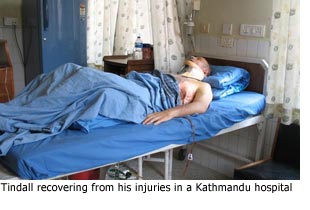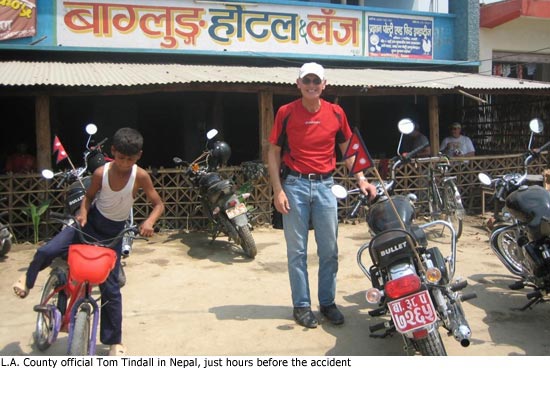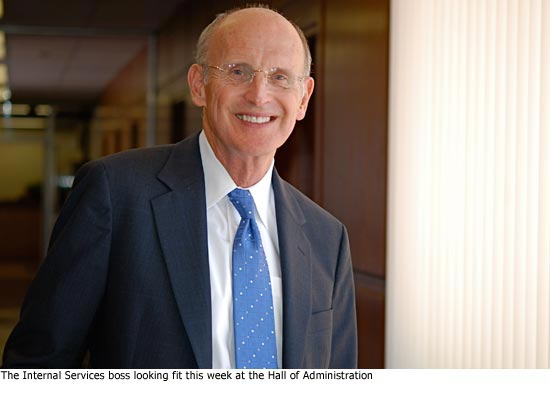His body was broken but not his will
June 16, 2010
When Tom Tindall thinks about life and death these days, he knows the distinction can sometimes be measured in inches and seconds.
“A lot of times people come close to death,” says Tindall, one of Los Angeles County’s top officials. “A lot of times, the truck just misses them and they go on with their lives. The truck didn’t miss me.”
In early April, while Tindall and his wife were touring Nepal on a motorcycle, he was struck from behind by an out-of-control truck that launched him into a concrete wall. He suffered three fractured vertebrae in his neck, broken collar bones on both sides, a cracked sternum, a broken left scapula, a separated shoulder, eight broken ribs and two punctured lungs, one of which collapsed completely. The other functioned barely enough to keep him alive.
“Breath,” he says, “was my struggle.”
Remarkably, just 11 weeks later, Tindall has now begun to return to his job as director of the Internal Services Department, whose 2,000 employees are responsible for everything from information technology services to the maintenance of county buildings. Tindall was named ISD’s director in 2008, after more than a decade of work with the county.
“I refuse to believe that I cannot come back 100% from this thing,” says the lanky 60-year-old, an avid runner and hiker. “Two weeks after the accident, after trying to walk, I thought to myself that I’m going to be in a wheel chair for the rest of my life. But then I told myself, ‘No!’ This is something I need to keep working on and be positive about. It crossed my mind to go on disability but then I wouldn’t be where I am now—getting better.”
 Looking at Tindall these days, you’d be hard pressed to see any evidence of the trauma that nearly killed him. The only outward sign is that he now tilts slightly to the left, the result of a fractured shoulder blade that will require extensive physical therapy. But without a shirt, he says, it’s not so pretty. “I look like Frankenstein,” he says, because of scars and indentations from broken bones.
Looking at Tindall these days, you’d be hard pressed to see any evidence of the trauma that nearly killed him. The only outward sign is that he now tilts slightly to the left, the result of a fractured shoulder blade that will require extensive physical therapy. But without a shirt, he says, it’s not so pretty. “I look like Frankenstein,” he says, because of scars and indentations from broken bones.
Tindall’s recovery is all the more remarkable because of the accident’s location—far from the world of sophisticated Western medicine—in the village of Itahari in southeast Nepal.
Tindall and his wife, Okyo, arrived there late in the afternoon on April 4, Easter Sunday, the fourth day of a journey that began in the Nepalese capitol of Kathmandu. This was Tindall’s third trip to Nepal, his first as part of a small group touring on motorcycles.
When they rolled into Itahari at around 4:30 p.m., Tindall says his wife, who was riding on the back of his motorcycle, developed a cramp. Tindall suggested she take a seat in the pace car that had been driving behind them with extra gasoline—a move that potentially saved her from the kind of physical wreckage that was about to claim her husband.
As the group began slowly making its way through town, a truck apparently failed to recognize that traffic had slowed and plowed into Tindall.
“Next thing I know,” Tindall says, “I woke up in a police vehicle transporting me to a clinic.”
Thirty miles later, they arrived at that clinic only to learn that the X-ray machine was broken. The next day, a helicopter transported him back to Kathmandu. On the advice of a locally-based American doctor, he was admitted to B & B Hospital, where, among many other things, his vertebrae were fused and wired together. He remained in Nepal for a month, until his lungs had improved enough for him to be flown back to the U.S. During that time, he says, L.A. County Chief Executive Officer William T Fujioka often checked in with him.
In recent days, Tindall, a former Army paratrooper, says he’s begun getting back in shape, walking two miles in the evening as well as going to physical therapy several times a week. He’s now in the office on many days, meeting with Internal Services staffers and getting the department ready for one of its newest jobs—administering a program to help homeowners finance solar energy installations through a special loan program.
On a deeper level, Tindall says, he’s still reflecting on how he’s been changed by his near-death experience in the land of Mt. Everest.
He says that, in his darkest hours, he prayed for help when he was struggling to breathe, despite the religious doubts he’s harbored throughout the years. But to his surprise, he says, “I found comfort, and it moved me closer to some kind of sense that you can give yourself over to the unknown…I don’t know how you can go through something like this without a renewed view of your life and its connections to something bigger.”
Posted 6/16/10














 405 bridge work causes a stink
405 bridge work causes a stink
